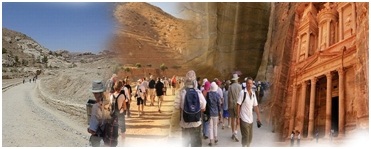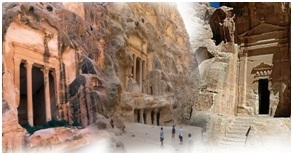Petra
It has to be seen to be believed, one of the greatest wonders ever wrought by Nature and Man
The giant red mountains and vast mausoleums of a departed race have nothing in common with modern civilization, and ask nothing of it except to be appreciated at their true value,
Although much has been written about Petra, nothing really prepares you for this amazing place.
Petra, the world wonder, is without a doubt Jordan’s most valuable treasure and greatest tourist attraction. It is a vast, unique city, carved into the sheer rock face by the Nabataeans, an industrious Arab people who settled here more than 2000 years ago, turning it into an important junction for the silk, spice and other trade routes that linked China, India and southern Arabia with Egypt, Syria, Greece and Rome.
Entrance to the city is through the Siq, a narrow gorge, over 1km in length, which is flanked on either side by soaring, 80m high cliffs. Just walking through the Siq is an experience in itself. The colors and formations of the rocks are dazzling. As you reach the end of the Siq you will catch your first glimpse of Al-Khazneh (Treasury), this Is an awe-inspiring experience. A massive façade, 30m wide and 43m high, carved out of the sheer, dusky pink rock- face and dwarfing everything around it. It was carved in the early 1st century as the tomb of an important Nabataean king and represents the engineering genius of these ancient people.
The Treasury is merely the first of the many wonders that make up Petra. You will need at least four or five days to really explore everything here. As you enter the Petra valley you will be overwhelmed by the natural beauty of this place and its outstanding architectural achievements. There are hundreds of elaborate rock-cut tombs with Intricate carvings - unlike the houses, which were destroyed mostly by earthquakes, the tombs were carved to last Throughout the afterlife and 500 have survived, empty but bewitching as you file past their dark openings. Here also is a massive Nabataean-built, visitor can find a Roman-style theatre (which could seat 3,000 people), Obelisks, Temples, sacrificial altars and colonnaded streets, and a high above, overlooking the valley is the impressive Ad-Deir Monastery – a flight of 800 rock cut steps takes you there.
Important Note• For your safety, all tourists are requested to exit the Park before sunset.
• Sleeping inside the Park is prohibited.
• Be sure to wear comfortable walking shoes and a hat to protect you from the sun, and always carry plenty of drinking water. • It is not permitted for motorized vehicles to enter the site. But if you don’t want to walk, you can hire a horse or a horse-drawn carriage to take you through the one kilometer Siq. For the elderly and/or handicapped, the Visitors' Centre, will issue a special permit (at an extra fee), for the carriage to go inside Petra to visit the main attractions. Once inside the site, you can hire a donkey, or for the more adventurous, a camel - both come with handlers and take designated routes throughout the site.
• Please do not purchase any antiquities, be they rocks or coins. There is no way of knowing whether they are real. Destroying the natural archaeology of the site will damage Petra for future tourists.
• The best time to see Petra, especially if you’re planning to take photographs, is either early to mid-morning or late afternoon, when the angled sun highlights and enhances the amazing natural colors’ of the rocks.
• The Petra Archaeological Park covers a vast area that contains many archaeological relics and a unique natural landscape. It will take you a full day to see the main sites inside Petra and longer to explore other attractions and areas off the beaten track.
• Visitors to Petra can choose from a number of trails to follow, two of which are guided while the rest require an experienced local guide to escort visitors. The trails are as follows:
SELF-GUIDED TRAILS Visitors can explore the self-guided trails on their own

The Main Trail
Start: Visitor Center
End: Qasr El Bint
Duration: 2 ½ – 3 hours (4km)
Grade: Easy
This trail begins by taking you past some fascinating monuments carved out of the rock such as Djinn block tombs, the obelisk tomb and an Ancient dam. These lead you into the Siq, a natural narrow gorge that is over a kilometer long. It serves as the main entrance into Petra and is certainly the most dramatic way in. The Siq meanders gently towards the ancient city and opens onto a spectacular view of the Treasury (Al Khazna), an intricate façade, which first greets the visitor. The trail then takes you past a street of facades, the theatre, a colonnaded street and Ends at Qasr El Bint where you can have your lunch in one of the two restaurants nearby and see the museums located there.
The Royal Tombs Trail
Start: After the theatre
End: Al Khubtha High Place
Duration: 2 ½ – 3 hours
Grade: Easy
This trail is an easy hike and begins when you turn right off the main trail when reaching the restrooms beyond the theater. Follow the staircase up to the Urn Tomb, Silk Tomb, Corinthian Tomb and Palace Tomb, after which you can walk down to the Nymphaeum, the Byzantine church and the winged lion temple and finally reach the museum.
GUIDED TRAILS
(Do not attempt any of these trails without a licensed guide)
Umm Al Biyara Trail
Start: Nymphaeum
End: Um Al Biyara
Duration: 3 – 4 hours
Grade: Hard
This trail begins 150m before the Nymphaeum and turns left past the Great Temple and Pharaoh’s Column after which you climb up the staircase of Umm Al Biyara and eventually reach the summit of Umm Al-Biyara.
Ad Deir Trail
Start: Museum
End: Ad Deir
Duration: 2 ½ - 3 hours (4km)
Grade: Hard
This trail begins from the museum inside Petra, which is located next to the Basin restaurant. It leads you northwards up ancient steps and after a short walk you reach the lion triclinium, which is set in a small side wadi on the left. Continue past this up the carved stairway to reach a hermitage with chambers excavated in the rock and decorated with many carved crosses. You then move on upwards to reach Ad Deir, which lies a short way beyond and offers a fantastic view over the area.
High Place Trail
Start: Siq exit
End: Qasr al-Bint Temple
Duration: 3-3½ hours
Grade: Hard
As its name suggests, the High Place sits high above the main area of Petra and getting there involves a steep climb, but the views you will have are certainly rewarding. The trail begins shortly after the exit from the outer Siq where you will climb up ancient Nabataean steps. At the top you can stop to take in the magnificent panorama before turning right to descend to Wadi Farasa to see the Lion Fountain, Garden Triclinium, Roman Soldier Tomb, Renaissance Tomb and Az Zantur excavation.
Al Madras Trail
Start: Obelisk Tomb
End: Al Madras (oil press)
Duration: 30 mins to 1 hour
Grade: Medium
This is a short trail that offers a beautiful hike just outside the siq. The trail takes you west after passing the Obelisk Tomb and before reaching the dam; it crosses an ancient bridge which the Nabataeans built to cross the wadi. It follows an ancient staircase leading to the top of Al Madras where you will find an oil press, cistern, and several sacred relics, including a high place and a meeting hall for the Nabataean holy society. Ancient roads were also opened here to link agricultural units or holy places around the area. During rainy days this trail is closed to avoid crossing the wadi, which is subject to sudden flooding in front of the Obelisk Tomb.
Al-Khubtha Trail
Start: Palace Tomb
End: Treasury viewpoint
Duration: 3 – 3½ hours
Grade: Hard
One of the main Nabataean suburbs of Petra was located on Al Khubtha Mountain, which forms a natural barrier on the eastern ridge of the Petra Basin. A newly restored stairway leads up to the site, providing easy access to the top of the mountain. A niche on the way is dedicated by Wahballah to the goddess al-Uzza and to the Lord of the Temple.
The most wonderful place you can go at night.
Petra by Night
To visit Petra during daylight is awe-inspiring; to experience it at night by the light of 1,800 candles is truly out-of-this-world! Walk through the Siq to the Khazneh following a candle-lit path and enjoy the haunting music of the Bedouins at the Treasury, Tours start at 8.30pm and finish at 10.00pm every Monday, Wednesday and Thursday, Tickets can be purchased from the Petra Site Office at the entrance to the site; Tickets cost JD 12 per person. And you must go inside with the group, talking is not recommend, you cannot imagine how magic all this can be.
Nearby sites
In addition to the main site of Petra there are several interesting sites close to Wadi Musa that can be visited while based in the town. These include:

Little Petra
A ten-minute drive north of Petra is Siq Al-Barid, which is also referred to as 'Little Petra' due to similarities with the main site. It is thought to have been an important suburb of Petra and is entered through a narrow opening, similar to the siq but of a much smaller scale. The site includes tombs, temples, water channels and cisterns carved out of the rock as well as the remains of frescoes on plaster.
Aaron's Tomb
It is believed that Moses' brother Aaron died and was buried in the Petra area and a white-domed mosque, built in the 14th century,
Commemorates this. It stands atop Aaron's Mountain (Jabal Harun), which is the highest peak in the area at 1350 meters above sea-level.
It has long been a place of pilgrimage for the locals, and is worth a trip if you have an extra day in Petra.
Good physical fitness is required for the long hike there and back